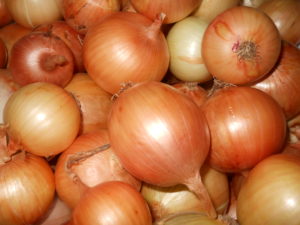
Why would you want to plant onions from seed?
Planting and growing onions from seed is easy and a great way to save money on onions. If you use lots of onions for cooking like we do, growing onions helps to reduce your grocery costs. We recommend growing several varieties of onions so you have them for use throughout the year. Different varieties will give you different flavors. Also, different varieties store differently. Ways of storing onions include curing and hanging, dehydrating, canning, pickling, making them into jellies, or freezing. We use all these methods of storage at the homestead. Of course, using fresh onions is great, too. Plus, who can resist a freshly picked spring onion either plain or with a little salt?
Additionally, we are avid gardeners so growing vegetables and fruits is a passion. There is a certain amount of accomplishment felt when you are able to produce your own food. Growing vegetables is also a way the homestead makes additional income. We have sold at markets in the past with great success. (I must say spring onions were always a “sell-out” at the farmer’s market). We miss doing the farmer’s markets, but due to time constraints, we now only sell from the farm. If you are local to James Creek, PA (Raystown Lake area) and interested in purchasing onions (or any of our other produce, honey, eggs, etc.) keep an eye out for our ads on social media and on our website. When product is available, we advertise and often it is sold out immediately.
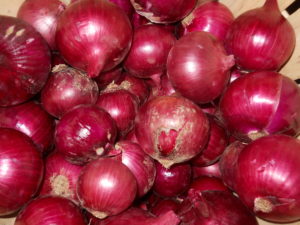
Growing your own onions also allows you the opportunity to try new varieties. Some onions are sweeter and some more spicy. Some are colorful and can give a dish a better visual appearance. You will never know the variety of flavors and colors unless you try them. Commercial groceries are often limited by the varieties they can carry due to storage, popularity, shipping times, shipping methods, or a myriad of other reasons. If you can grow them yourself you can try and share varieties that would not be available otherwise. Variety is the spice of life!
Finally, by growing your own onions you get to know exactly how the onions were grown. For us this is important as we do not wish to grow (or eat) vegetables grown with added synthetic chemicals. We choose a more organic approach to raising our food. (By organic, we are not talking the certification status, but an approach that we feel is right for us). This is our desire and no judgement to others that may have their own approach. For us, we do not know what was done to the produce at the commercial groceries. We have our own opinions on irradiation of produce, synthetic chemical use, and produce waxing, as well as other practices in consumer visual appeal and shelf life practices. We’ll let you make up your own mind on these practices. For us, it is not our desire to eat or support these practices, so growing our own is our preference.
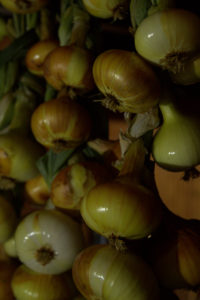
Step One: Pick Your Onion Seed
Your first step is to decide what seeds you want to grow. Many commercial seed houses carry onion seed. This year we have decided on the following varieties to order from Burpee seeds.
(Please note that the following are affiliate links. By clicking on the links, we receive a small commission at no additional cost to you. This helps our homestead and we thank you from the bottoms of our hearts.)
- Onion Blush Hybrid. This is a new variety for us. We always grow a “keeper” onion (that’s what we call the long-term storage onions). We were not happy with the variety we grew last year and decided that we needed to find a new variety. One of the issues we had was rot occurring at the stem. This variety appears to have nice thin stems that should dry quickly and not hold moisture which we believe was the problem we were having. We will keep you posted on how this new variety does for us.
Link: https://sovrn.co/ucdkjms
- Cippolini Red Onion. These onions are a beautiful purple color. They are a smaller onion and we often find that we need to use multiple ones for a single meal, however, they are worth it. This is a proven variety that we’ve grown in the past. Many people have remarked at how good they are. Whether for personal use or for market growing, we highly recommend this variety.
Link: https://sovrn.co/1haw6j9
- Italian Torpedo Onion. These are beautiful slender pink colored onions. We chose this variety for two reasons: taste and appearance. One thing we like to do is showcase vegetables that have unusual appearances. This not only starts conversations with customers and visitors to the homestead, but also educates consumers that not all vegetables have the same appearance. In our commercialized world, most people only recognize the global shaped white onion. It’s refreshing to show that other shapes and colors exist…and they’re delicious!
Link: https://sovrn.co/17dw47u
- Evergreen Long White Bunching Onion. This is an heirloom variety that we are told are cold-hardy (perfect for our area) and disease resistant. This is also a new variety for us. This variety should not bulb, but should give us the slender spring onion that we love. We cannot wait to try these and hopefully our customers will like them as well.
Link: https://sovrn.co/eozczud
Step Two: Plant Your Onion Seed
Here in Pennsylvania, we typically start our onions indoors in February. Consult your growing zone for information as to when to plant if you are in a different location. Typically, you will want to start your seeds between six to 10 weeks prior to the last frost date for your area.
We use growing flats to start our seeds, but anything that you can put a couple of inches of dirt in will work. You can start the seeds in a potting mix or use your own custom starting mix. We use our own mixture of composted manure, peat moss, and dirt with a little green sand, dried blood, and crushed minerals mixed in.

Sow the seeds thinly and cover them with about a quarter inch of your potting mix. You want to keep the seeds moist (we use a spray bottle to water the trays). Keep the trays in an area with an even temperature. An area between 60 to 65 degrees Fahrenheit is ideal, but onions can germinate anywhere between 50- and 95-degrees Fahrenheit.
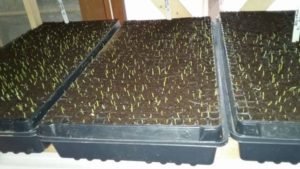
In about a week or two, you should see the seedlings emerging. They will look like little blades of grass as they poke through the soil. At this point, they will need about 16 hours of light and 8 hours of darkness per day. We use fluorescent lights that we hang a couple inches above the tops of the seedlings. Our lighting is set up to move upward as the seedlings grow. We would recommend using fluorescent or LED lighting to grow the onions as it should not overheat and burn out the young seedlings. Ideal temperature for onion growth is 55- to 75-degrees Fahrenheit.
According the Burpee, you may need to fertilize the seedlings at 3 to 4 weeks of age. We have never done this as our potting mix seems to have enough fertility to sustain the seedlings until the time of planting outside. Experimentation will give you your answer as to whether you need the extra fertilization.
We grow our seedlings to the size of a thin pencil. At this point (and providing that we are past the heavy frost stage), we begin to harden off our seedlings.
Step Three: Transplant Your Onion Plants to the Garden
Either prior or while the seedlings are hardening off, we prepare our garden beds for the onion transplants. Onions like sunlight, so choose a location with full sun. We do not plant the same vegetable in the same area as the previous year. This helps to reduce problems if a previous year had a bug infestation or disease. This gives the area an extra season to heal before planting the same crop. Make sure your planting bed has some fertility and has good drainage. Optimal pH for onions is 6.0 – 7.0. We typically use compost and mix in with the top layer of soil. Onions are a light feeder.
Companion plants for onions include lettuce, pepper, spinach, strawberry, carrots, parsnips, chicory, radishes, beets, and tomato. Incompatible plants for onions include beans, asparagus, peas and sage. Keep this in mind when planning your other vegetables and fruits so you can maximize your yields.
Plant the hardened off onion transplants about 3 to 4 inches apart. If you plan on harvesting the onions as spring onions or scallions, we reduce the planting to 2 inches apart. Since we use raised beds, we space our rows the same as plant spacing (3-4 inches). However, if you are a field gardener, Burpee recommends 1-2 feet between your rows.
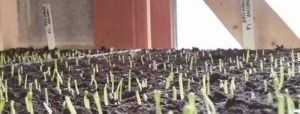
Keep your onions watered and moist during their growing season, but not in standing water. We usually stick our finger in the soil and if we don’t feel moisture by the first knuckle, we water immediately. However, we try to keep the soil with constant moisture. Onions have shallow roots, so don’t let the ground get dry or your onions won’t grow very large.
Step Four: Harvesting Your Onions
If you are using your onions as green onions or scallions, pick them when the stalks are thin. We pick ours when the tops are about 8” to a foot high.
If you are harvesting onion bulbs, you will know they are ready when about a third of the plants have yellowed and fallen over. We pull ours out of the ground at this point and let them cure in a dry area outside. For us, this is an open porch area with good ventilation and no beating sun. If you don’t have such an area, you can let the onions lay in the field covered by their own foliage. You just don’t want the bulb to be exposed to the direct sun. Keep the onions outside for about a week before bringing indoors.
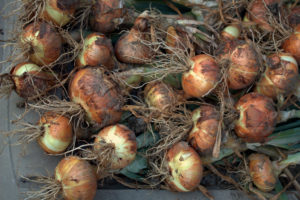
Once indoors, keep the onions in a dry ventilated area for about two to three weeks. You can then cut the foliage off about an inch above the bulb. Alternatively, we braid the onions and hang them to let them finish curing.
Cured onions are sometimes left hanging or placed in bushel baskets and stored in a cool, dry location. Make sure to wipe off dirt and loose skin prior to storing. Check the onions occasionally for moisture or rot and remove any that show signs of problems. One rotting onion can cause problems for all the onions around it. Ideal storage temperature is 36- to 40-degrees Fahrenheit with 65-75% humidity. Onions will store for between one and eight months depending on the variety.
Pests, Diseases, and Problems
Onions are typically very easy to grow, but sometimes bad things happen. The following is a list of common mishaps with onions.
Japanese Beetle
The Japanese beetle is about ½” in length with shiny green and copper colored wings. Japanese Beetles feed on plants.
Onion Eelworm
Eelworms are nematodes. Nematodes are blind and microscopic. The effect the onion by causing malformed flowers, leaves, stems and roots. Eelworms are more common in sandy or loamy soils and can remain in soils for many years.
Onion Maggot
Onion maggots are white worms about 1/3” in length that taper to a pointed head. They feed on stems and bulbs. The onion maggot becomes a fly as it matures. The onion maggot will cause faded and wilted leaves. Often, plants will yellow and collapse from onion maggots.
Slugs
Slugs are large 1/2“ to 10” long slimy mollusks. They feed on plants.
Thrips
Thrips are very tiny straw colored or black slender insects with a pair of wings. They suck plant juices, scrape plants, and sting plants, and can transmit spotted wilt.
White Grub
White grubs are ¾” to 1-1/2” long, plump, white worms with brown heads and legs near the head. The adult is a beetle. White grubs feed on roots of plants and cause sudden wilting.
Wireworm
Wireworms are ¼ to 3/4th inches long. They are thin, yellow brown worms with a shiny skin. The mature to click beetles. Wireworms live in the soil and kill seedlings by girdling stems at the soil line and boring into stems, roots and tubers.
Botrytis
Botrytis is a fungus that can cause an onion to reduce to a slimy mess. It starts with light tan, white, or gray spots that develop to a darker colored fungus that eventually destroys the plant. Also known as gray mold.
Downy Mildew
This is a fungus that typically causes distinctively yellowed leaves.
Smut
Smut is a fungus. It usually attacks young seedlings and causes lesions near the base of the bulb. There will also be streaks on the leaves, sheaths and bulbs that will mature into black powdery spores. Smut stunts the growth of the plant. Smut can live in soil for several years so it is always good practice to not plant the same plants in the same areas year after year.
Sunscald
Sunscald causes bleached and slippery tissue during curing and is caused by curing the onion in direct sunlight.
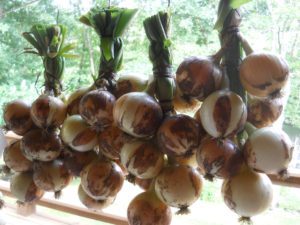
Conclusion
Onions are an easy gardening crop to grow. There are many varieties to choose from and flavors vary from pungent to sweet. They don’t require much space and can be stored and preserved by several ways for future use. Although things can go wrong, we believe most of the time things go right with a little care and a watchful eye. Planting your own onions is relatively inexpensive and can provide a sense of accomplishment and self-reliance.
We hope you’ll try growing some this year.
Sources:
Denckla, Tanya L. K., The Gardener’s A-Z Guide to Growing Organic Food., Storey Publishing. Versa Press, United States. 2003. ISBN: 13.978-1-58017-370-4, ISBN: 10-1-58017-370-5.
Holzer, Sepp. Sepp Holzer’s Permaculture., Chelsea Green Publishing. Vermont. 2004. ISBN: 978-1-60358-370-1.
Seymour, John. The New Self-Sufficient Gardener., DK Publishing, United States. 2008. ISBN: 978-0-7566-2898-7.
Whittingham, Jo, Backyard Harvest., DK Publishing, United States. 2011. ISBN: 978-0-7566-7163-1.
Disclosure of Material Connection: Some of the links in this page or post may be “affiliate links”. This means that if you click on the link, Pioneer Mountain Homestead, LLC may receive an affiliate commission at no direct cost to you. Pioneer Mountain Homestead, LLC only recommends products or services that the owners, managers, or employees of Pioneer Mountain Homestead, LLC use or believe will add value to the readers of this website. This disclosure is made with the Federal Trade Commission’s 16 CFR, Part 255: “Guides Concerning the Use of Endorsements and Testimonials in Advertising.”
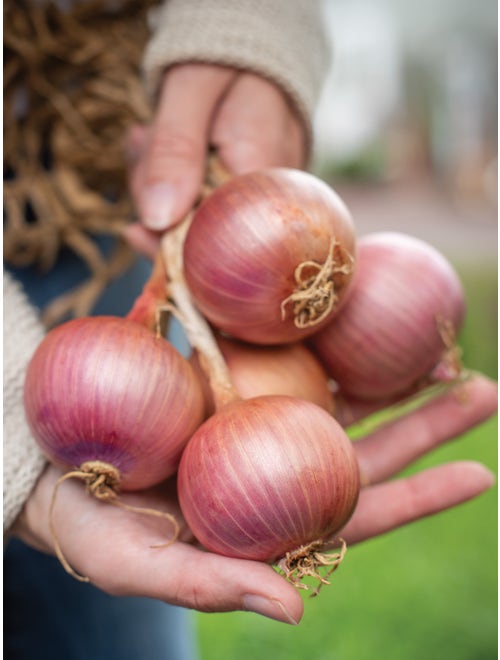
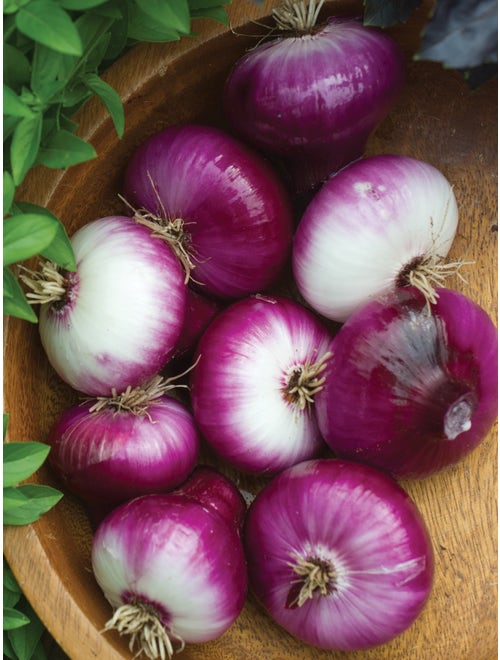
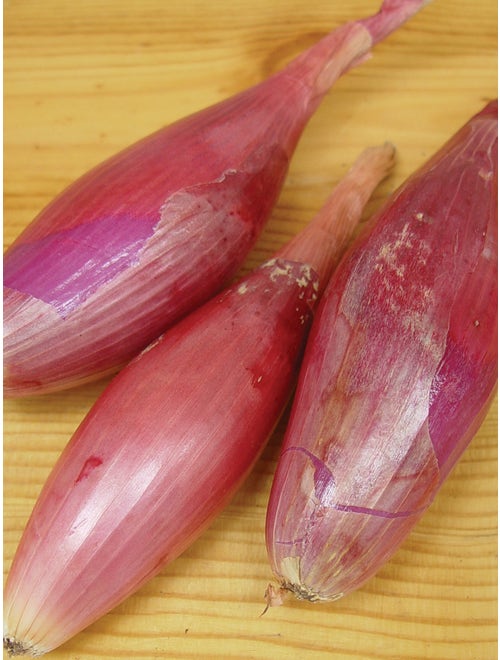

Great content! Keep up the good work!
Thank you. I hope you will try planting onions and let us know your results.